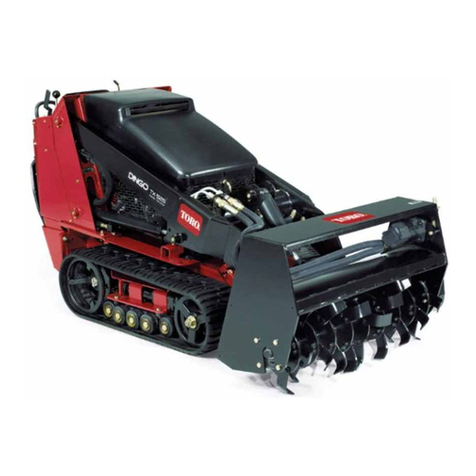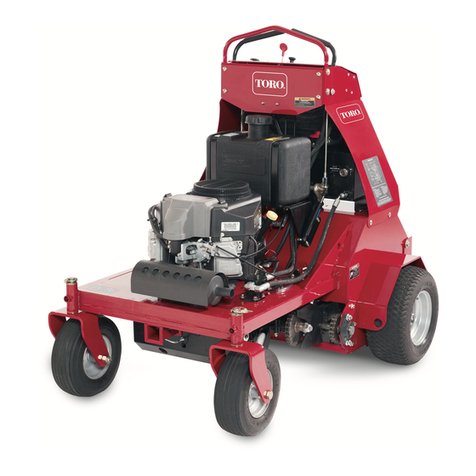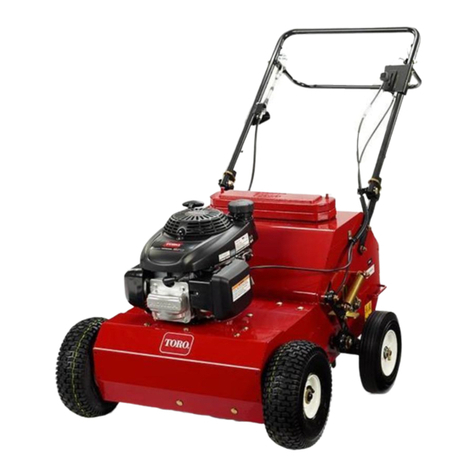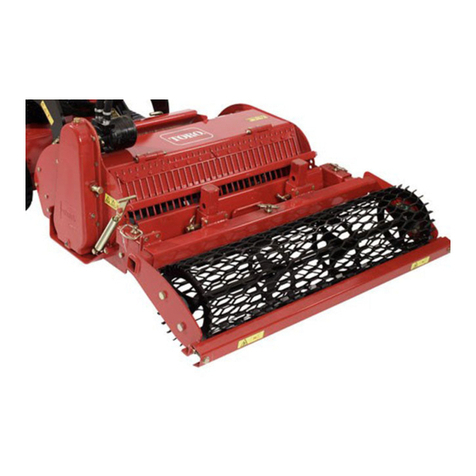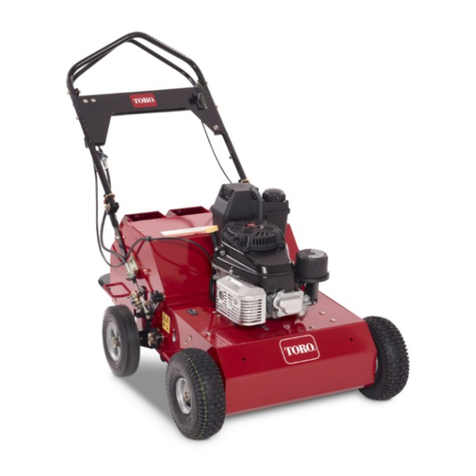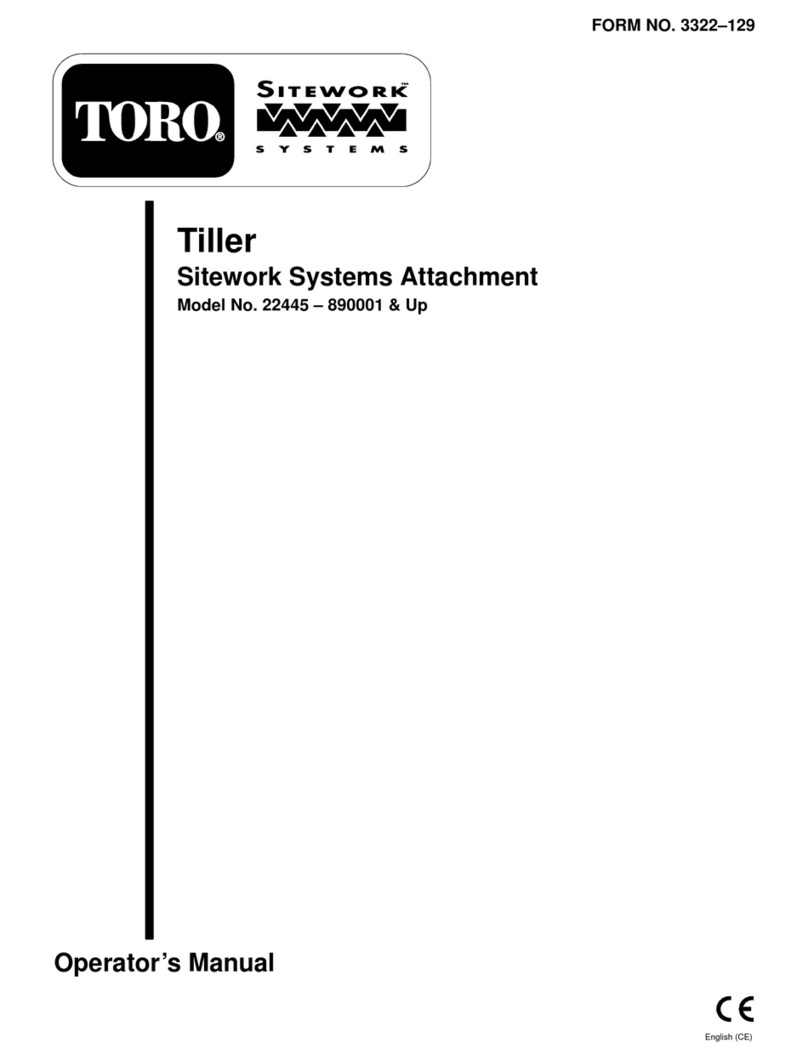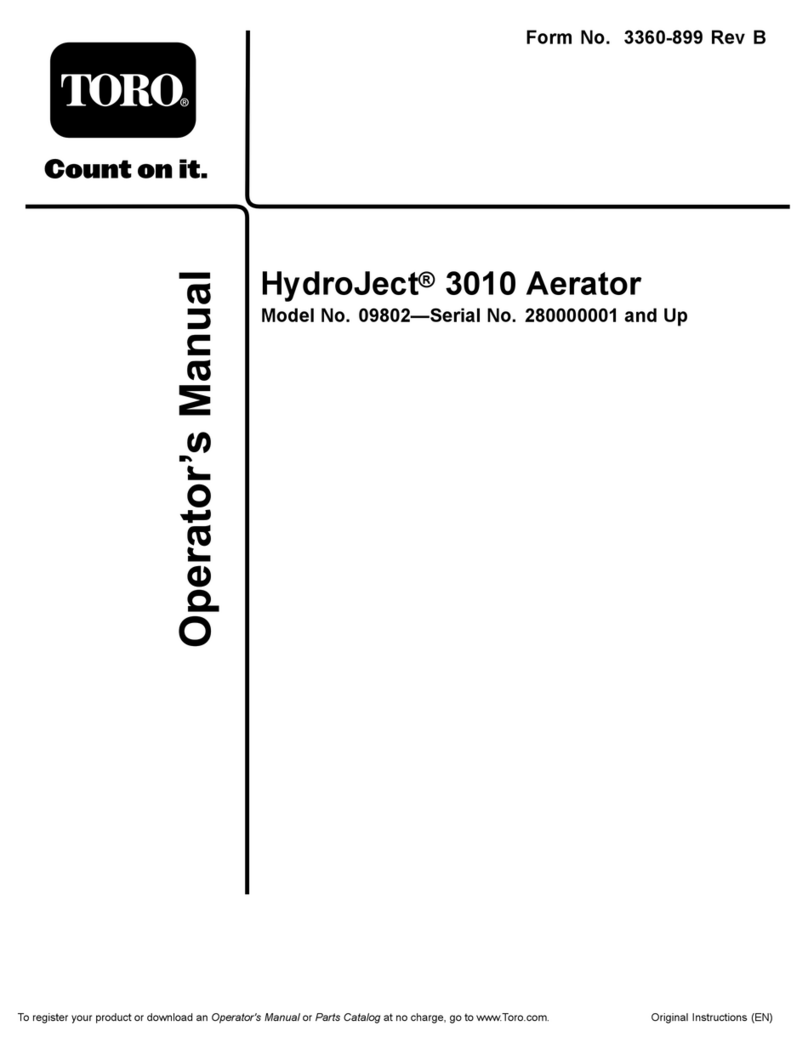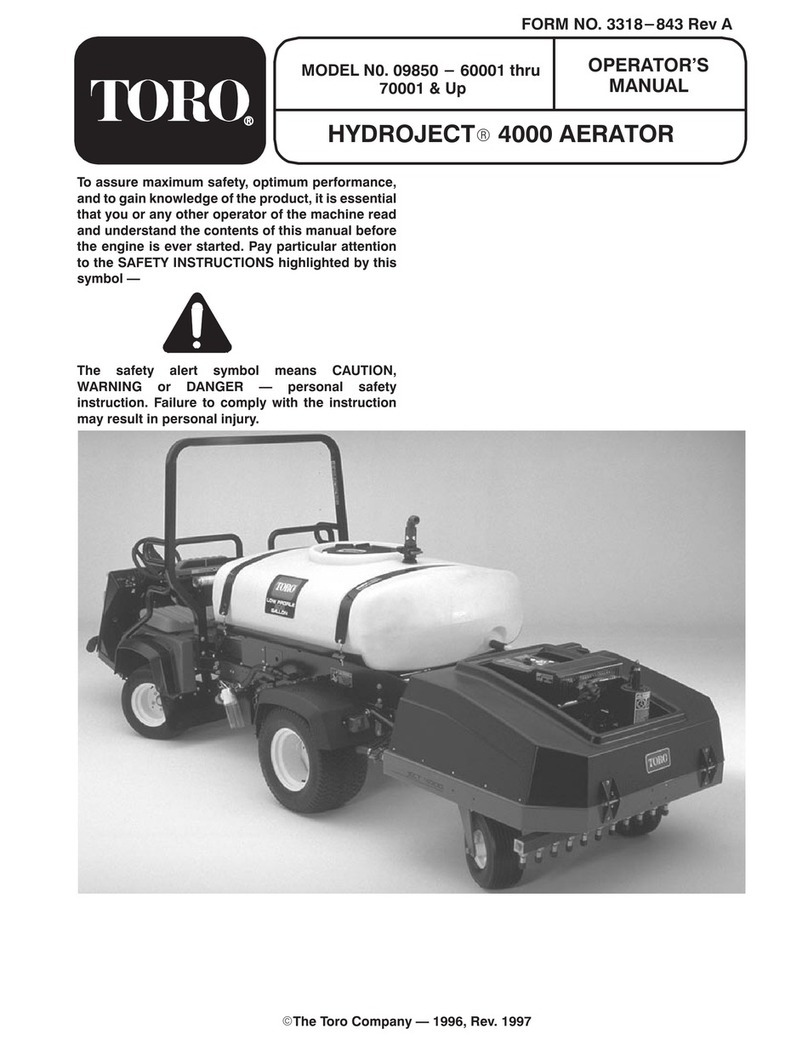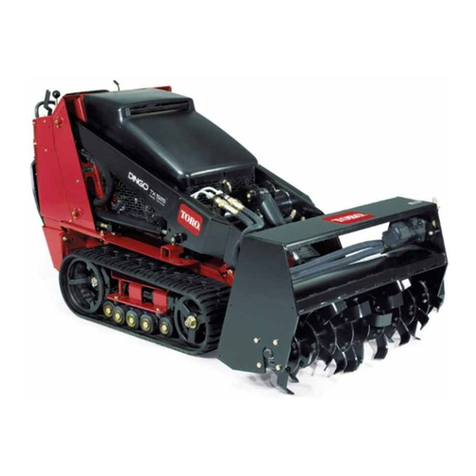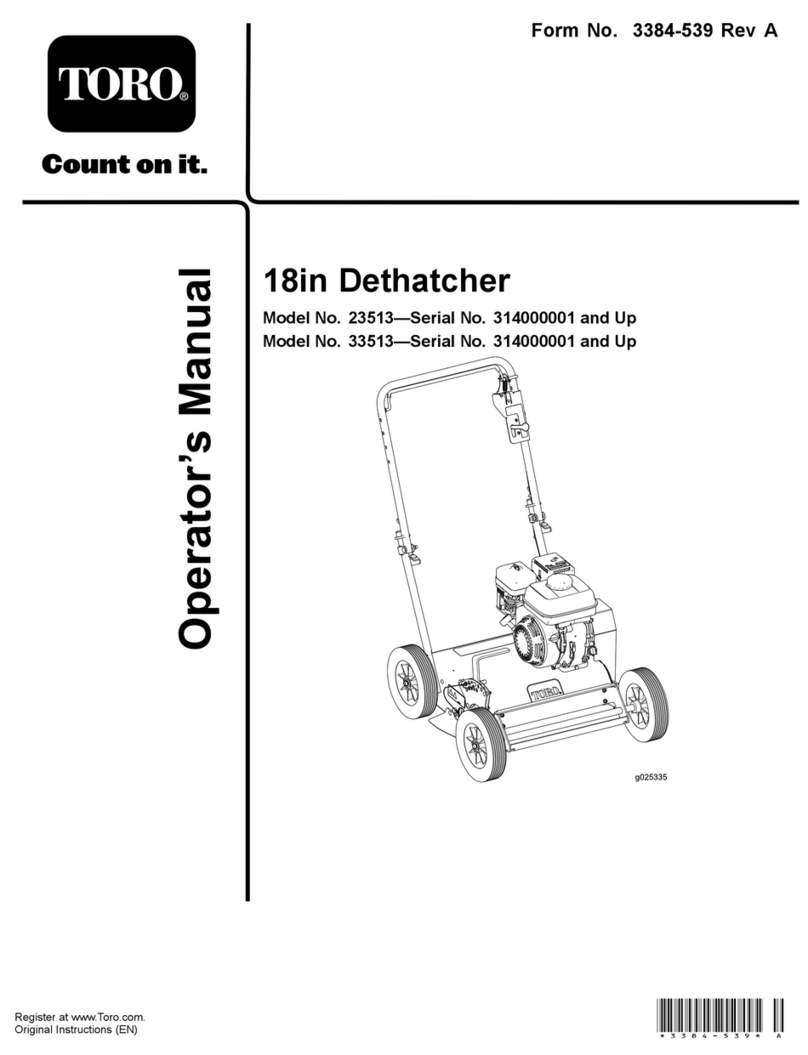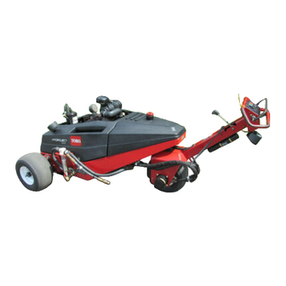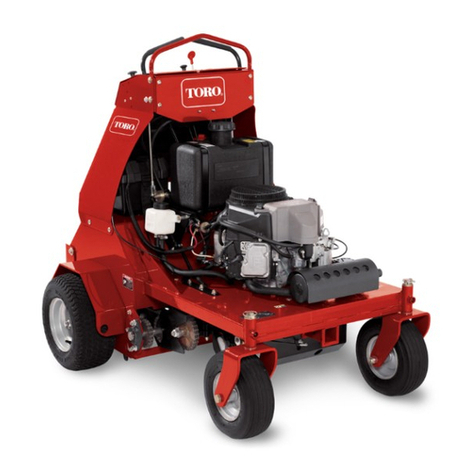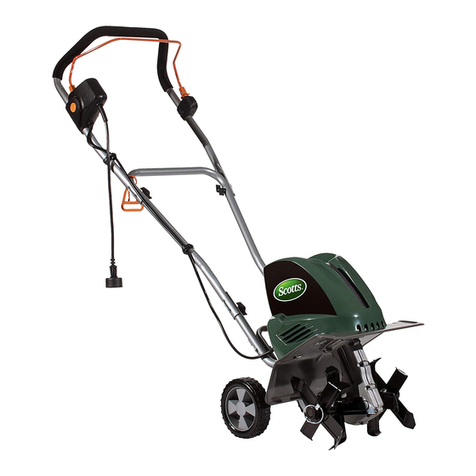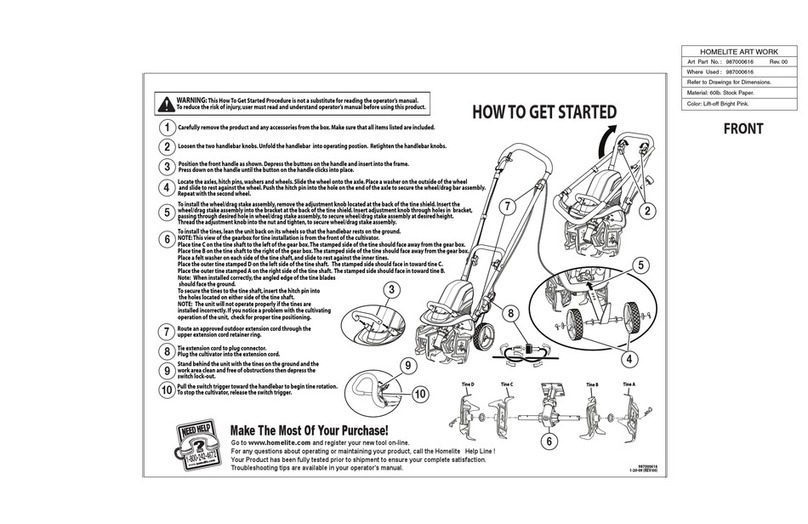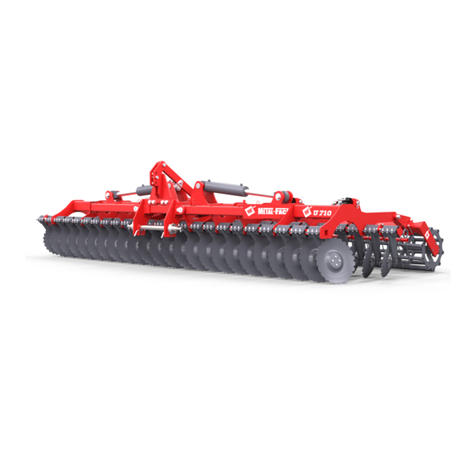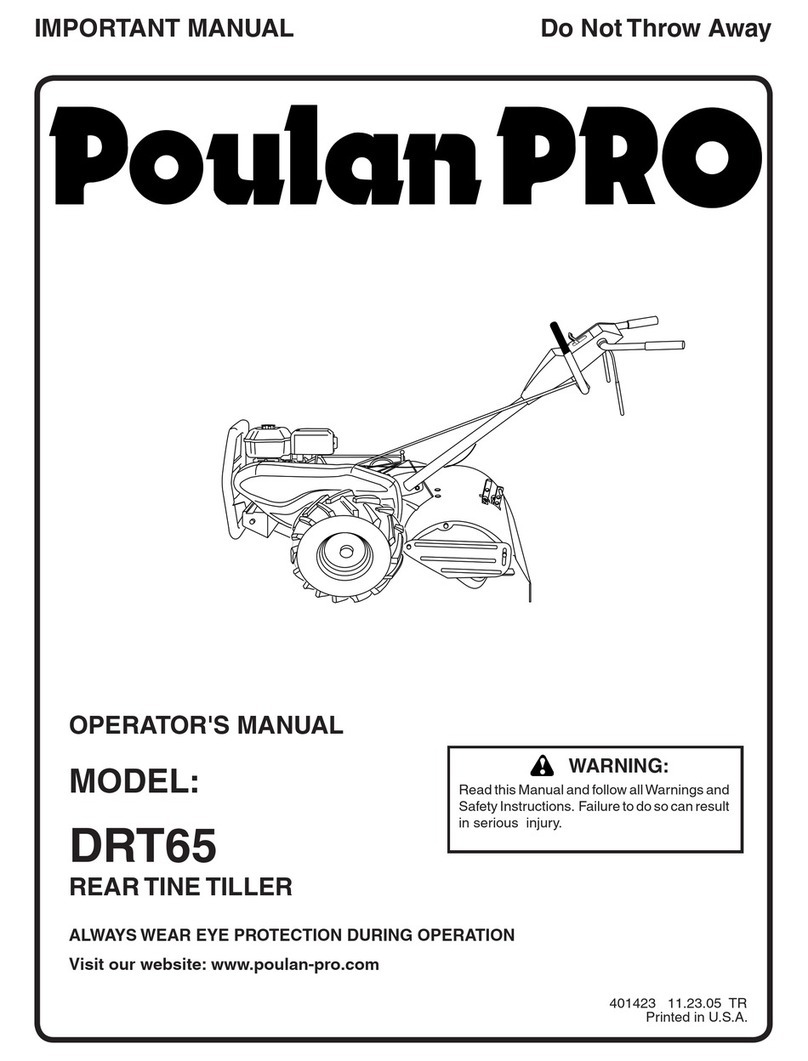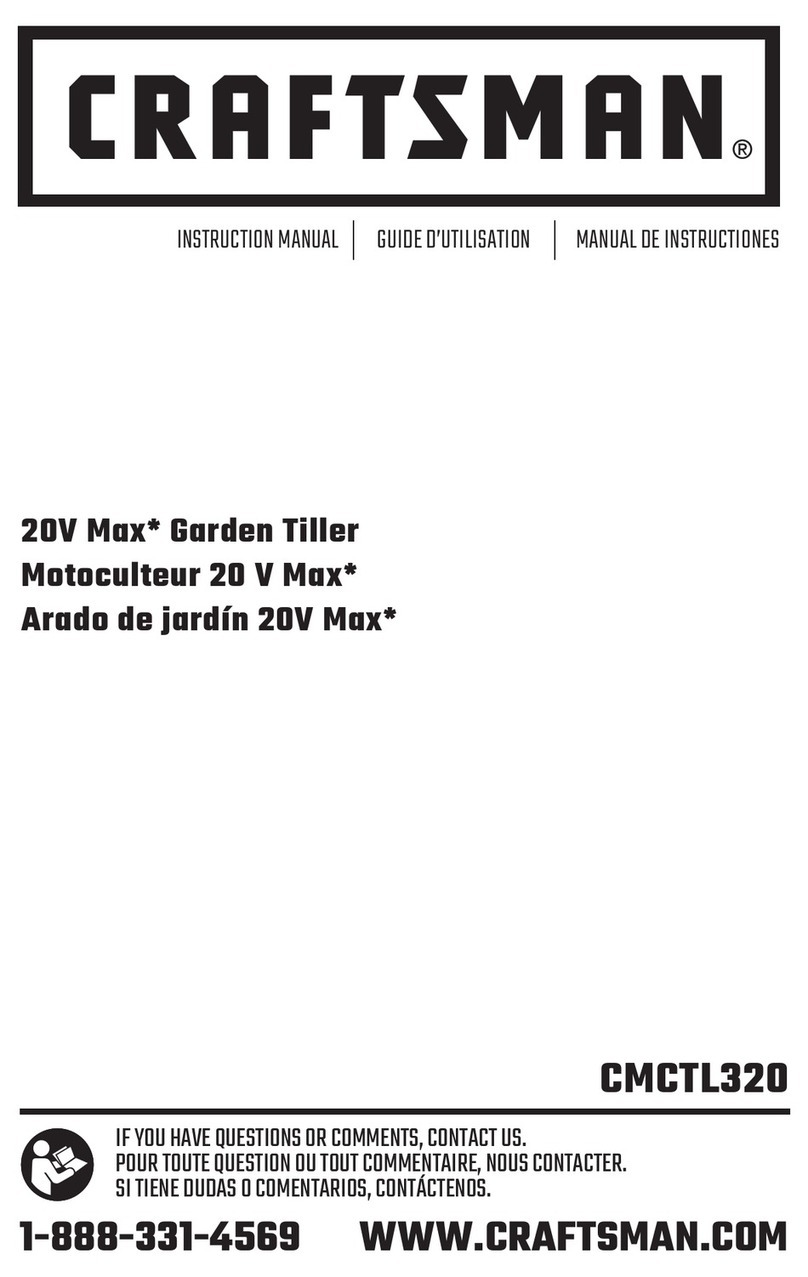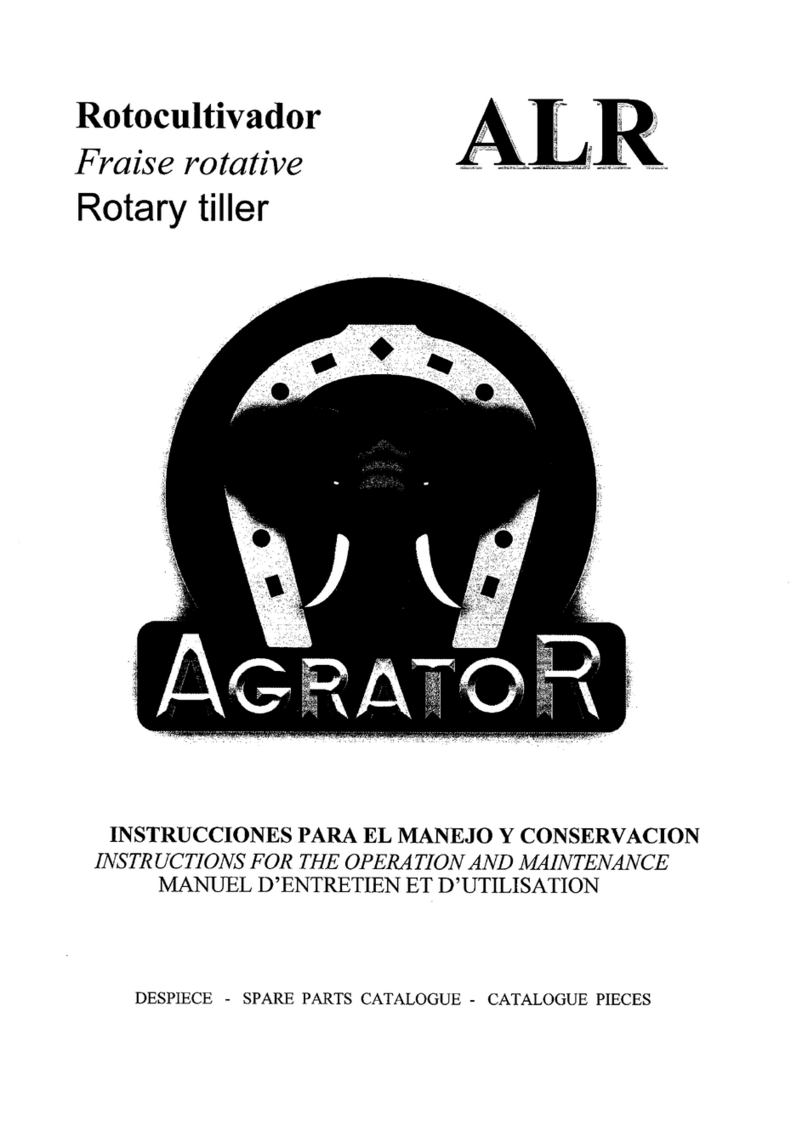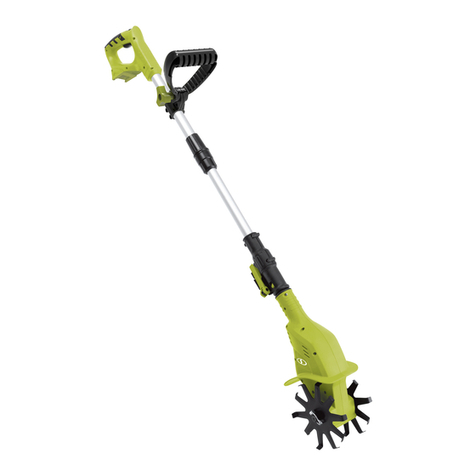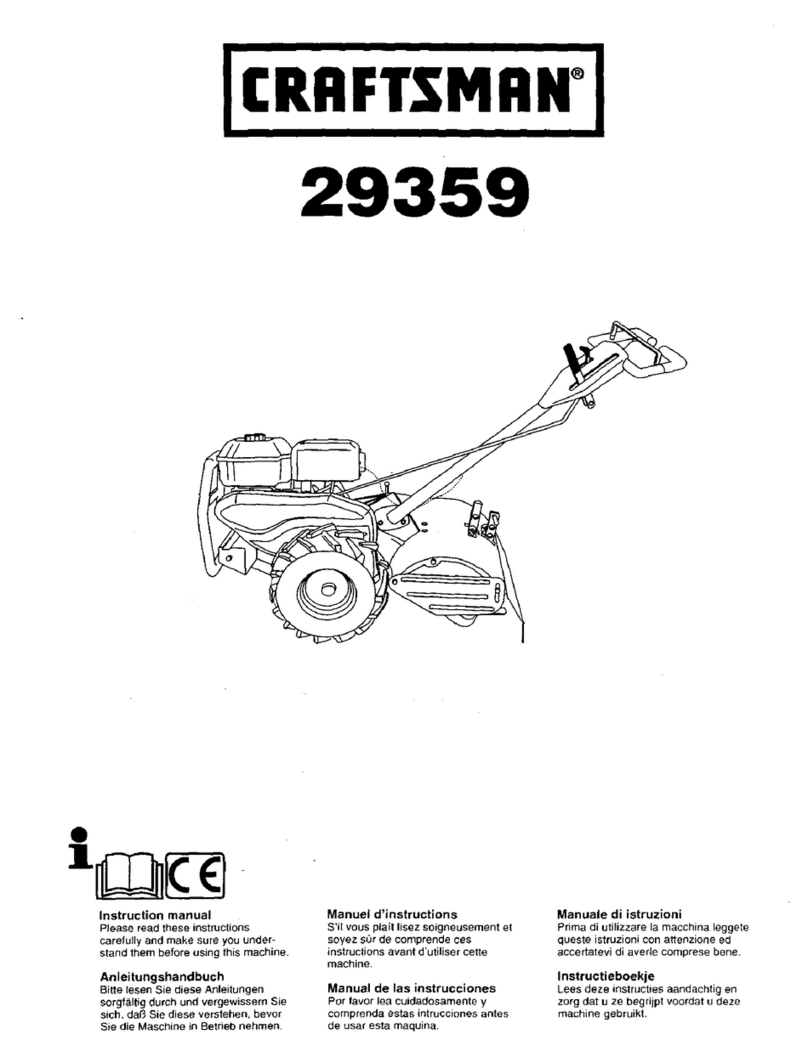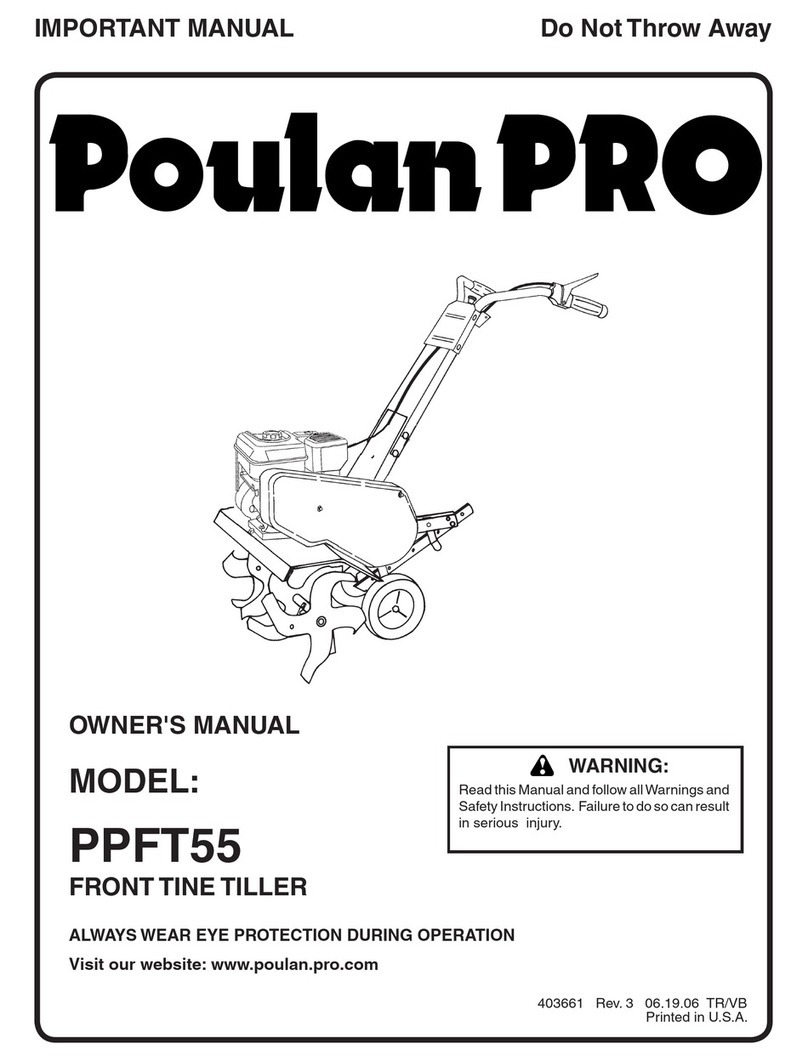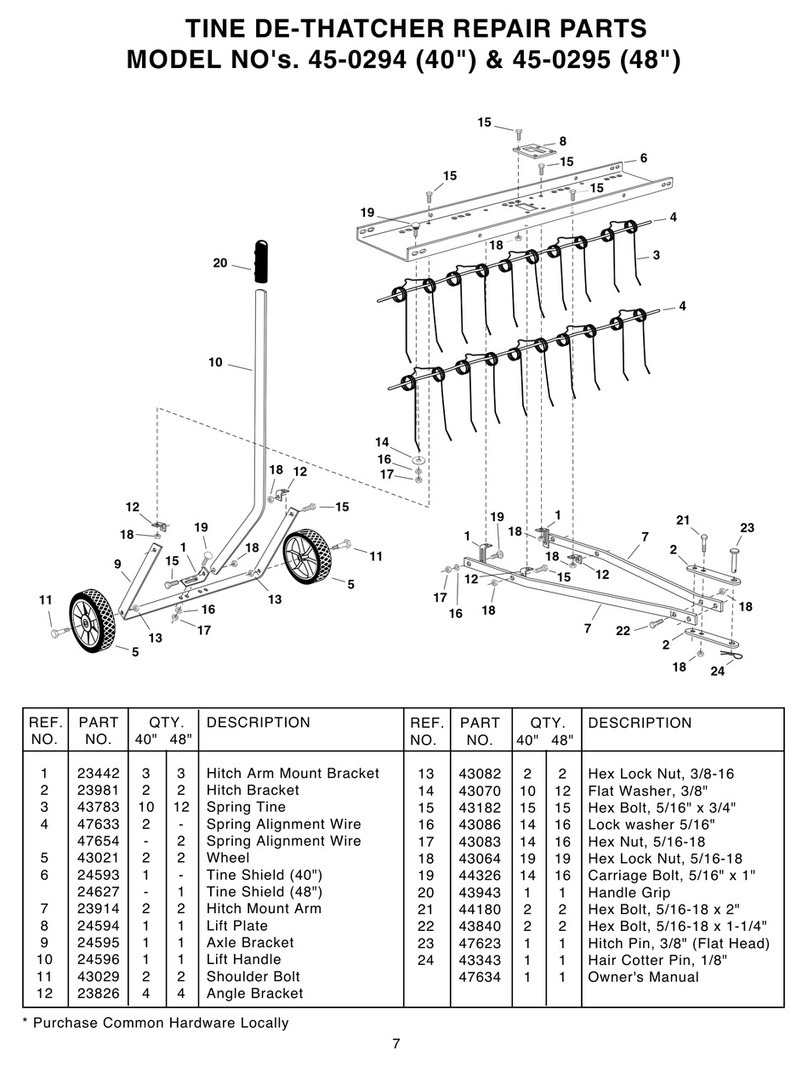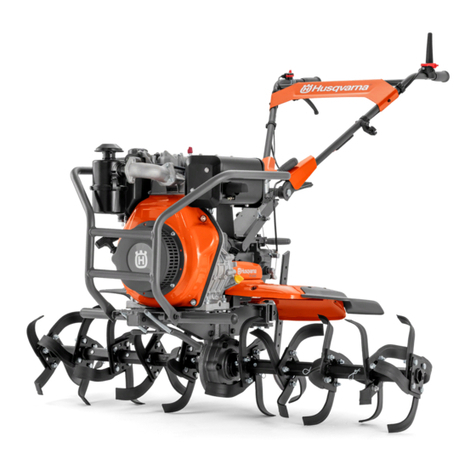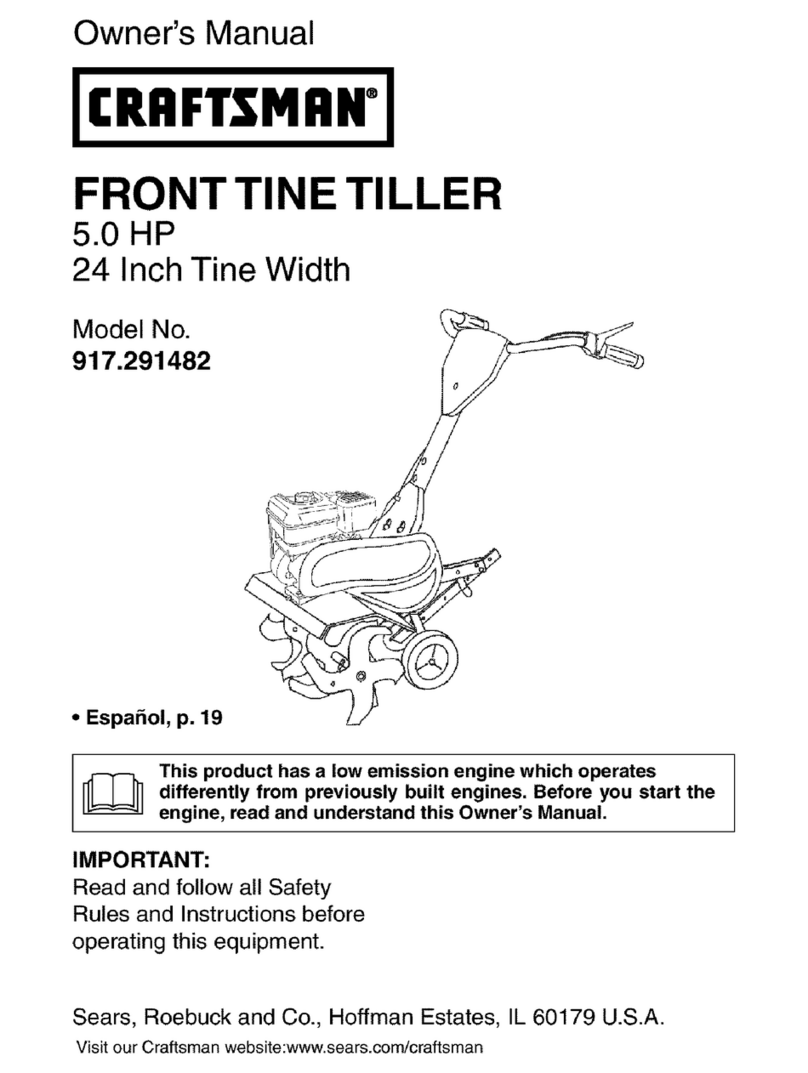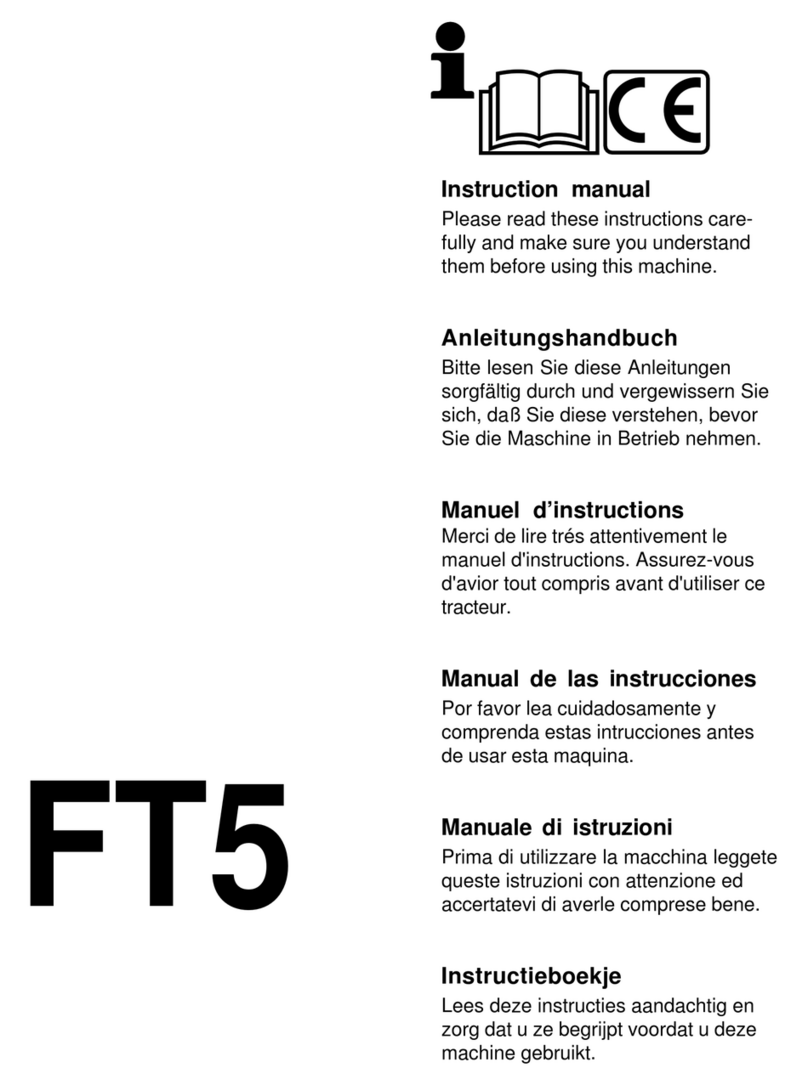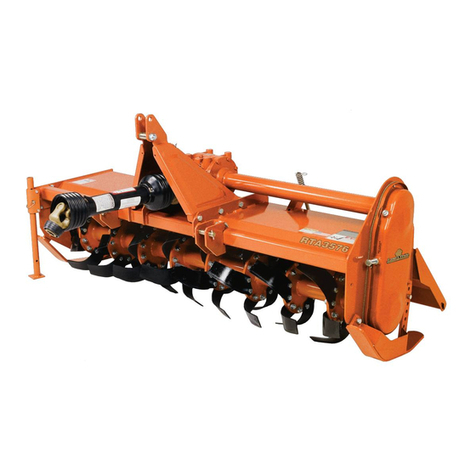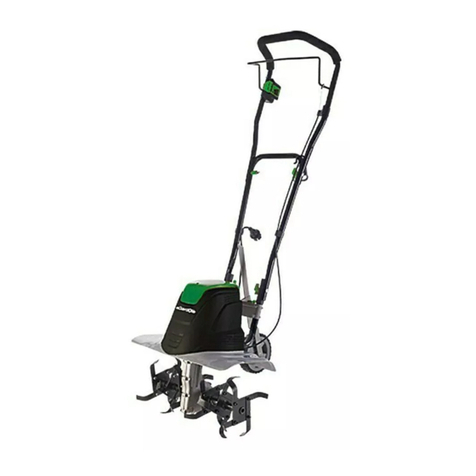Toro 9801 User manual

Operator’s Manual
Domestic English (EN)
Form No. 3325-801 Rev. A
Hydroject)3000
Aerator
Model No. 09801—210000001 and Up

2
All Rights Reserved
Printed in the USA
W2001 by The Toro Company
8111 Lyndale Avenue South
Bloomington, MN 55420-1196
The engine exhaust from this product contains
chemicals known to the State of California to cause
cancer, birth defects, or other reproductive harm.
Warning
This spark ignition system complies with Canadian
ICES-002.
Ce système d’allumage par étincelle de véhicule est
conforme à la norme NMB-002 du Canada.
Contents
Page
Introduction 2. . . . . . . . . . . . . . . . . . . . . . . . . . . . . . . . .
Safety 3. . . . . . . . . . . . . . . . . . . . . . . . . . . . . . . . . . . . . .
Before Operating 3. . . . . . . . . . . . . . . . . . . . . . . . . .
While Operating 3. . . . . . . . . . . . . . . . . . . . . . . . . . .
Maintenance 4. . . . . . . . . . . . . . . . . . . . . . . . . . . . . .
Safety and Instruction Decals 5. . . . . . . . . . . . . . . . .
Specifications 7. . . . . . . . . . . . . . . . . . . . . . . . . . . . . . . .
General Specifications 7. . . . . . . . . . . . . . . . . . . . .
Controls 8. . . . . . . . . . . . . . . . . . . . . . . . . . . . . . . . .
Water Injection System 8. . . . . . . . . . . . . . . . . . . . .
Dimensions 8. . . . . . . . . . . . . . . . . . . . . . . . . . . . . . .
Depths and Nozzle Configurations 9. . . . . . . . . . . .
Fluid Recommendations 10. . . . . . . . . . . . . . . . . . . . .
Setup 11. . . . . . . . . . . . . . . . . . . . . . . . . . . . . . . . . . . . . .
Loose Parts 11. . . . . . . . . . . . . . . . . . . . . . . . . . . . . . .
Installing the Rear Wheels 11. . . . . . . . . . . . . . . . . . .
Before Operating 12. . . . . . . . . . . . . . . . . . . . . . . . . . . . .
Activating and Charging the Battery 12. . . . . . . . . . .
Checking the Engine Oil 13. . . . . . . . . . . . . . . . . . . .
Filling the Gas Tank 13. . . . . . . . . . . . . . . . . . . . . . . .
Checking the Gear Case Fluid Level 14. . . . . . . . . . .
Checking the Pump Case Fluid Level 14. . . . . . . . . .
Checking the Tire Pressure 15. . . . . . . . . . . . . . . . . .
Water System Accumulator 15. . . . . . . . . . . . . . . . . .
Operation 15. . . . . . . . . . . . . . . . . . . . . . . . . . . . . . . . . . .
Controls 15. . . . . . . . . . . . . . . . . . . . . . . . . . . . . . . . .
Operating Precautions 17. . . . . . . . . . . . . . . . . . . . . .
Starting and Stopping the Engine 17. . . . . . . . . . . . . .
Training Period 17. . . . . . . . . . . . . . . . . . . . . . . . . . . .
Operating Procedure 17. . . . . . . . . . . . . . . . . . . . . . .
Checking the Interlock System 19. . . . . . . . . . . . . . .
Transport Operation 19. . . . . . . . . . . . . . . . . . . . . . . .
Inspection and Clean-Up After Use 19. . . . . . . . . . . .
Pushing or Towing the Machine 20. . . . . . . . . . . . . .
Page
Maintenance 21. . . . . . . . . . . . . . . . . . . . . . . . . . . . . . . . .
Recommended Maintenance Schedule 21. . . . . . . . .
Daily Maintenance Checklist 22. . . . . . . . . . . . . . . . .
Lubricating the Machine 23. . . . . . . . . . . . . . . . . . . .
Servicing the Pre-Filter 24. . . . . . . . . . . . . . . . . . . . .
Replacing the Main Water Filter 24. . . . . . . . . . . . . .
Changing the Engine Oil and Filter 25. . . . . . . . . . . .
Servicing the Air Cleaner 26. . . . . . . . . . . . . . . . . . . .
Adjusting the Carburetor 26. . . . . . . . . . . . . . . . . . . .
Checking and Replacing the Spark Plugs 27. . . . . . .
Cleaning the Cylinder Head Fins 28. . . . . . . . . . . . . .
Changing the Gear Case Oil and Filter 28. . . . . . . . .
Changing the Pump Case Oil 28. . . . . . . . . . . . . . . . .
Checking the Hydraulic Lines and Hoses 29. . . . . . .
Adjusting the Traction Pump Belt 29. . . . . . . . . . . . .
Adjusting the Transmission for Neutral 30
. . . . . . . . .
Adjusting the Aeration Speed 30. . . . . . . . . . . . . . . .
Adjusting the Parking Brake 31. . . . . . . . . . . . . . . . .
Adjusting the Roller Spray Wash System 31. . . . . . .
Servicing the Spray Wash Nozzles or Strainers 32. . .
Caring for the Battery 32. . . . . . . . . . . . . . . . . . . . . .
Electrical Schematic 33. . . . . . . . . . . . . . . . . . . . . . . .
Water System Schematic 34. . . . . . . . . . . . . . . . . . . .
Hydraulic Schematic 34. . . . . . . . . . . . . . . . . . . . . . .
Seasonal Storage 35. . . . . . . . . . . . . . . . . . . . . . . . . . . . .
Preparing the Water System 35. . . . . . . . . . . . . . . . . .
Preparing the Engine 35. . . . . . . . . . . . . . . . . . . . . . .
Preparing the Traction Unit 35. . . . . . . . . . . . . . . . . .
Troubleshooting 36. . . . . . . . . . . . . . . . . . . . . . . . . . . . . .
The Toro Aerator Commercial Products Warranty 40. . .
Introduction
Read this manual carefully to learn how to operate and
maintain your product properly. The information in this
manual can help you and others avoid injury and product
damage. Although Toro designs and produces safe
products, you are responsible for operating the product
properly and safely.
Whenever you need service, genuine Toro parts, or
additional information, contact an Authorized Service
Dealer or Toro Customer Service and have the model and
serial numbers of your product ready. The model and serial
numbers are stamped on a plate which is riveted to the
frame.

3
Write the product model and serial numbers in the space
below:
Model No.
Serial No.
This manual identifies potential hazards and has special
safety messages that help you and others avoid personal
injury and even death. Danger, Warning, and Caution are
signal words used to identify the level of hazard. However,
regardless of the hazard, be extremely careful.
Danger signals an extreme hazard that will cause serious
injury or death if you do not follow the recommended
precautions.
Warning signals a hazard that may cause serious injury or
death if you do not follow the recommended precautions.
Caution signals a hazard that may cause minor or moderate
injury if you do not follow the recommended precautions.
This manual uses two other words to highlight information.
Important calls attention to special mechanical
information and Note: emphasizes general information
worthy of special attention.
Safety
Hazard control and accident prevention are dependent upon
the awareness, concern, and proper training of the
personnel involved in the operation, transport,
maintenance, and storage of the machine. Improper use or
maintenance of the machine can result in injury or death.
To reduce the potential for injury or death, comply with the
following safety instructions.
Before Operating
•Read and understand the contents of this Operator’s
Manual before operating the machine. Become familiar
with all of the controls and know how to stop quickly. A
free replacement manual is available by sending your
complete Model and Serial Number to:
The Toro Company
8111 Lyndale Avenue South
Bloomington, Minnesota 55420
•Never allow children to operate the machine. Do not
allow adults to operate the machine without proper
instruction. Only trained operators who have read this
manual should operate this machine.
•Never operate the machine when under the influence of
drugs or alcohol.
•Before attempting to start the engine, engage the
parking brake.
•Remove all debris or other objects that might interfere
with operation. Keep all bystanders away from the work
area.
•Keep all shields and safety devices in place. If a shield,
safety device, or decal is damaged, repair or replace it
before operation is commenced. Also tighten any loose
nuts, bolts, and screws to ensure that the machine is in
safe operating condition.
•Do not operate machine while wearing sandals, tennis
shoes, sneakers, or shorts. Also, do not wear loose
fitting clothing which could get caught in moving parts.
Always wear long pants and substantial shoes. Wearing
safety glasses, safety shoes, ear protection, and a helmet
is advisable and required by some local ordinances and
insurance regulations.
•Fill the fuel tank with gasoline before starting the
engine. Avoid spilling gasoline. Since gasoline is
flammable, handle it carefully.
– Use an approved gasoline container.
– Do not fill the tank while the engine is hot or
running.
– Do not smoke while handling gasoline.
– Fill the fuel tank outdoors and up to about one in.
(25 mm) from the top of the tank, not the filler neck.
– Wipe up any spilled gasoline.
•Check the interlock switches daily for proper operation.
If a switch fails, replace it before operating the
machine. The interlock system is for your protection, so
do not bypass it. Replace all interlock switches every
two years.
While Operating
•Do not take an injury risk! When a person or pet
appears unexpectedly in or near the working area, stop
aerating.
•Keep hands and feet away from the nozzle and roller
area. High velocity water jets can penetrate hands and
feet. Penetration by the high velocity water jets can
cause serious personal injury. If accidental penetration
occurs, seek medical attention immediately.
•Never use chemicals in the water supply system.
•Do not operate the water injection system on concrete
or asphalt because water jets will permanently damage
these surfaces.
•Start the engine with the parking brake engaged.

4
•Do not run the engine in a confined area without
adequate ventilation. Exhaust fumes are hazardous and
could possibly be deadly.
•Using the machine demands attention. To prevent loss
of control:
– Use only in daylight or when there is good artificial
light.
– Watch for holes or other hidden hazards.
– Do not transport machine close to a sand trap, ditch,
creek, or other hazard.
•If the machine starts to vibrate abnormally, shut the
engine off. Remove the wires from the spark plugs to
prevent possibility of accidental starting. Check the
machine for damaged parts. Repair any damage before
restarting the engine and operating the machine.
•Do not touch the engine or muffler while the engine is
running or soon after it is stopped. These areas could be
hot enough to cause a burn.
•Before leaving the operator’s position (behind the
handle), engage the parking brake.
•When leaving the machine unattended, engage the
parking brake, shut the engine OFF, and remove the key
from the ignition switch.
Maintenance
•Disconnect the wires from the spark plugs to prevent
accidental starting of the engine when servicing,
adjusting, or storing the machine.
•If the machine must be tipped to perform maintenance
or an adjustment, close the fuel shut-off valve, drain the
gasoline from the fuel tank, the oil from the crankcase,
and remove the battery.
•To reduce the potential for a fire hazard, keep the
engine free of excessive grease, grass, leaves, and
accumulation of dirt.
•Be sure that the machine is in safe operating condition
by keeping nuts, bolts, and screws tight. Check all bolts
and nuts frequently to be sure that they are tightened to
specification.
•If the engine must be running to perform a maintenance
adjustment, keep hands, feet, clothing, and other parts
of the body away from any moving parts.
•Make sure that all hydraulic line connectors are tight
and all hydraulic hoses and lines are in good condition
before applying pressure to the system.
•Keep your body and hands away from pin hole leaks or
nozzles that eject water or hydraulic fluid under high
pressure. Use paper or cardboard, not your hands, to
search for leaks. Hydraulic fluid or water escaping
under pressure can have sufficient force to penetrate
skin and do serious damage. If either of these fluids are
injected into the skin they must be surgically removed
within a few hours by a doctor familiar with this form
of injury or gangrene may result.
•Before disconnecting or performing any work on the
hydraulic oil system, all pressure in the system must be
relieved by stopping the engine and opening the bypass
valve.
•Before disconnecting or performing any work on the
water system, all pressure in the system must be
relieved by stopping the engine and opening the bleed
valve. Opening the bleed valve allows any trapped
water to escape from the system and also allows the
accumulator piston to move to the bottom of the
accumulator cylinder.
•The accumulator in this machine contains high pressure
dry nitrogen. Accumulator servicing requires special
tools and precautions. Accumulators do not contain user
serviceable components. Improper accumulator
servicing can cause dismemberment or death. Do not
attempt to disassemble a accumulator; have this work
done by an Authorized Toro Distributor.
•Do not overspeed the engine by changing the governor
settings. To be sure of safety and accuracy, have an
Authorized Toro Distributor check the maximum engine
speed with a tachometer.
•The engine must be shut off before checking the oil or
adding oil to the crankcase.
•Allow the engine to cool before storing the machine in
any enclosure such as a garage or storage shed. Make
sure that the fuel tank is empty if the machine is to be
stored in excess of 30 days. Do not store the machine
near any open flame or where gasoline fumes may be
ignited by a spark. Always store gasoline in a safety
approved, red metal container.
•When storing or transporting the machine (trailering),
make sure that the fuel shut-off valve is closed.
•Perform only those maintenance instructions described
in this manual. If major repairs are ever needed or
assistance is desired, contact an Authorized Toro
Distributor. To ensure optimum performance and safety,
always purchase genuine Toro replacement parts and
accessories. Never use “will-fit” replacement parts
and accessories made by other manufacturers. Look for
the Toro logo to ensure genuineness. Using unapproved
replacement parts and accessories could void the
warranty.

5
Safety and Instruction Decals
Safety decals and instructions are easily visible to the operator and are located near any area
of potential danger. Replace any decal that is damaged or lost.
80-8000
80-8070
80-9350
80-8290
80-8880
80-8090
80-8760
80-8040
80-8010
80-8150 (Replace control panel)
1. Choke

6
80-8110 (Replace control panel)
1. Slow throttle 2. Fast throttle
80-9240
IMPORTANT
THE FIVE MICRON FILTER ELEMENT (86-8620) MUST
BE IN PLACE AT ALL TIMES.
OPERATION WITHOUT PROPER FILTRATION WILL
RESULT IN PREMATURE WEAR AND FAILURE OF THE
WATER SYSTEM COMPONENTS.
USE OF ADDITIONAL FILTRATION OR POTABLE WATER
MAY BE NECESSARY TO PROLONG THE LIFE OF THE
FILTRATION SYSTEM.
D
D
D
SEE OPERATOR'S MANUAL FOR MORE INFORMATION.D
92-9542
80-8020
72-4080
93-9429
80-8030
80-9450

7
Specifications
Note: Specifications and design subject to change without notice.
General Specifications
Engine
Onan, 4 cycle, opposed twin, air cooled, 24 hp @ 3600 RPM, 60 cu. in (983 cc)
displacement. Electric start. Heavy duty valve package. Extended service air
cleaner. 3 quart oil capacity. Solid state ignition. Meets California Exhaust Emission
Standard for 1995 Lawn and Garden Equipment.
Clutches Electromagnetic, dual groove belt drive for water pump and driveshaft flange
brake/clutch for main valve gearbox.
Electrical
12 volt system with 20 amp circuit breaker protection. Relays for all high current
switching. Electronic controller and sensors for automatic startup and shutdown
sequence of water injection system. Group 28 battery with 525 cold crank amps.
Traction Drive
Closed loop hydrostatic drive consisting of Sundstrand variable volume pump and
Parker low speed, high torque wheel motor mounted to steering fork. Hydraulic
system contains 5 quarts with 25 micron suction line filter and gearbox reservoir.
Tires/Wheels
Three, smooth tread 2 ply, 18 x 9.50-8,pneumatic tubeless, tires. Demountable
drop center steel wheels with 4 lug nuts mounted to tapered roller bearing hubs on
transport arms and brake hub on wheel motor. All are interchangeable.
Brake Drum and shoe-type parking brake mounted to wheel motor. Holds unit on a 30%
grade.
Transport Lift 12 volt Warner Electric linear screw actuator with 6 inch stroke. Raises and lowers
lift arm/transport tires and activates hole spacing control.
Fuel Capacity 10.5 gallons gasoline
Ground Speed Aerating: 0–2 MPH (both directions)
Transport: 0–4 MPH (both directions)
Aeration Width 33 inches with 11 nozzles on 3 inch centers
Aeration Depth 4 to 6 inches depending on turf conditions and nozzle configuration
Hole Pattern Variable from 1-1/2 to 6 in. spacing in the direction of travel, and 3 or 6 in.
increments in width
Controls
Engine Panel Throttle, choke, spray wash control, hour meter, water pressure gauge, spacing
control lever, key switch, and circuit breaker reset button
Steering Tiller Panel Traction bail, water system engage and disengage buttons, transport/aerate lift
toggle switch, and parking brake with buzzer alarm.
Electronic Control Module Solid state potted device for sequencing start and stop of water system. Interlocks
for water pressure, transport lift, and traction neutral.

8
Water Injection System
Pre-Filter Spin down type with washable cartridge in clear plastic housing and plastic ball
valve for flushing.
Supply Filter Replaceable cartridge in plastic housing with air bleed button.
Water Pressure Switch Senses for water pressure after filter and turns on when pressure is over 20–28 psi
and turns off when pressure drops below 7–13 psi.
Pump
Pump is a Toro exclusive design (patent pending) with cast stainless steel head
and 3 piston plungers. Vee packing seals and Kevlar guides. Forged crankshaft
with plasma sprayed ceramic on stainless steel plungers and cast iron connecting
rods. Nominal performance is 4 gpm @ 5000 psi with 1400 RPM input.
Accumulator Toro exclusive design with low charge pressure sensor, nitrogen gas charged to a
maximum of 2500psi.
Cam and Gearbox
Reduction gear drive for cam that actuates main water valve. Roller cam follower
rides on cam specifically designed (patent pending) to control water injection at 5.3
cycles per second (320 RPM) and store energy in accumulator between injections.
Cast iron case also serves as 4 quart hydraulic reservoir.
Valve
Cast stainless steel valve body functions as mounting base for accumulator,
gearbox, and manifold outlet. All high pressure water flows in and out through the
valve body. Pressure balanced valve spool with floating (patent pending), hardened
stainless seat aligns during assembly. Bleed valve in base allows for bleed-off of
high pressure and drain down for cold weather storage. Bolted flanges and
polyurethane o-rings mate all components to valve body.
Rollers
Pivoting aluminum rollers uniformly smooth the turf and provide protection from the
nozzle discharge. Adjustable flow (0–3 gpm) spray wash system with 6 flood tip
nozzles maintain clean rollers.
Pressure Relief Valve Circle Seal Controls poppet-type valve preset to 5000 psi with corrosion resistant
stainless and brass materials.
Manifold and Nozzles
Extruded stainless steel manifold with 11 flanged nozzle extensions containing
check valves and hardened stainless discharge orifice. Check valves may be
reversed in housing to block unused nozzles.
Dimensions
Length 96.2 in. (244 cm)
Wheelbase 53.2 in. (135 cm)
Width 63 in. (160 cm)
Height 42.7 in. (108 cm)
Weight 1150 lb. (522 kg)

9
Depths and Nozzle Configurations
All nozzles are identified with numbers indicating the drill size of the orifice. The standard configuration is 11 nozzles
producing depths of 4 to 6 inches depending on turf conditions. Blocked nozzle locations are obtained by reversing the nozzle
check valve ball and spring. See nozzle size chart and illustrations below:
Important Use only nozzle configurations shown or damage to the machine may occur.
Nozzle Size and Approximate Depth Chart
Part No
Drill Size
Decimal Metric Size Quantity of Nozzles A
pp
rox.
Part No. Drill Size
Decimal
Size (inch)
Metric Size
(mm) Open Blocked
Approx
.
Depth
86-8130 #56 0.0465 1.181 * * *
86-8131 #53 0.0595 1.511 11 04–6 in.
86-8133 #46 0.081 2.057 6 5 6–8 in.
* Use only with varied size configurations
Note: Aluminum Washer, Toro Part no. 80-6680, is required with any nozzle change.
Optional Staggered Size Nozzle Configuration
Part No
Drill Size
Decimal Metric Size Quantity of Nozzles A
pp
rox.
Part No. Drill Size
Decimal
Size (inch)
Metric Size
(mm) Open Blocked**
Approx
.
Depth
86-8130 #56 0.0465 1.181 6 and 0** 3–4 in.
86-8133 #46 0.081 2.057 5 0** 6–8 in.
** Additional nozzles may be blocked to compensate for pump wear.
Note: Aluminum Washer, Toro Part no. 80-6680, is required with any nozzle change.
C osed (B ocked) Nozz e
Open Nozzle
Spring
Spring Check Valve Ball
Check Valve Ball

10
Fluid Recommendations
Fuel
Unleaded regular gasoline recommended to minimize
engine intake valve and combustion chamber deposits.
Engine Oil
Service classification API SF, SG, SF/CC or SG/CC in a 30
weight viscosity grade.
Engine Oil Filter
Order Part No. 57-8530
Hydraulic Oil Filter
Order Part No. 67-8110
Hydraulic Oil
Mobil DTE 26 or other interchangeable equivalent. See the
chart below for equivalent oils.
Mobil DTE 26
Shell Tellus 68
Amoco Rykon Oil #68
Conoco Super Hydraulic Oil 68
Exxon Nuto H 68
Kendall Kenoil R&O 68
Pennzoil Penreco 68
Phillips Magnus A 68
Standard Energol HLP 68
Sun Sunvis 831 WR
Union Unax AW 68
Water Pump Case Oil
Mobil DTE Extra Heavy or other interchangeable ISO
Grade 150 PE-700-A (Heavy Inhibited Hydraulic &
General Purpose). See the chart below for equivalent oils.
Mobil DTE EH (Extra Heavy)
Shell Turbo 150
Amoco American Ind. Oil 150
Chevron AW Machine Oil 150
Conoco Dectol R & O 150
Exxon Terresstic 150
Kendall Ken-Tran 080
Pennzoil Penreco 150/AW 150
Phillips Magnus Oil 150
Standard Energol HLP 150
Sun Sunvis 150
Union Unax RX 150/Turbine Oil 150
Valvoline ETC (R&O) #70
Water Supply
Recommended source with 7–8 gallons per minute. A
minimum pressure of 30 psi at the machine is required for
the pump to engage. Maximum allowable pressure of 200
psi. Although irrigation water pumped from ponds or
effluent holding pools can be used, not all conditions can be
handled by the filtration system. Additional or alternative
filtration may be required.
Water Filter Cartridge
Order Part No. 86-8630
Important Do not use chemicals! Concern for
environmental issues and corrosive affects on machine
components.

11
Setup
Note: Determine the left and right sides of the machine from the normal operating position.
Loose Parts
Note: Use this chart as a checklist to ensure that all parts have been received. Without these parts, total setup cannot be
completed.
Description Qty. Use
Wheel
Lug nut
3
12 Installing the rear wheels
Ignition key 1Use in ignition switch.
Hose adapter 1Mount to quick coupler on side of machine.
Spanner wrench 1Use for installation and removal of water filter.
Parts catalog 1
Operator’s manual 1Read before operating the machine.
Registration card 1Fill out and return to Toro.
Installing the Rear Wheels
1. Remove the wheels from the shipping pallet.
2. Mount the wheels to the hubs with the lug nuts
(supplied in loose parts) (Fig. 1) and torque the nuts to
45–55 ft.-lb. (61–75 N⋅m).
3. Remove any shipping blocks or braces, which may
obstruct machine removal from the pallet.
Important Refer to the Before Operating section in this
manual, page 12, for instructions on preparing the machine
for operation.
1
2
Figure 1
1. Wheel 2. Lug nuts

12
Before Operating
Activating and Charging the
Battery
Battery posts, terminals, and related accessories
contain lead and lead compounds, chemicals
known to the State of California to cause cancer
and reproductive harm. Wash hands after
handling.
Warning
1. Since the battery is not filled with electrolyte or
activated, bulk electrolyte with 1.260 specific gravity
must be purchased from a local battery supply outlet.
Danger
Battery electrolyte contains sulfuric acid which is a
deadly poison and causes severe burns.
•Do not drink electrolyte and avoid contact with
skin, eyes or clothing. Wear safety glasses to
shield your eyes and rubber gloves to protect
your hands.
•Fill the battery where clean water is always
available for flushing the skin.
2. Release the hood latches and raise the hood.
3. Loosen the capscrew securing the battery clamp to the
machine and remove the battery (Fig. 2). Remove the
filler caps from the battery and slowly fill each cell until
electrolyte is just above the plates.
Battery terminals or metal tools could short
against metal aerator components causing sparks.
Sparks can cause the battery gasses to explode,
resulting in personal injury.
•When removing or installing the battery, do not
allow the battery terminals to touch any metal
parts of the aerator.
•Do not allow metal tools to short between the
battery terminals and metal parts of the aerator.
Warning
1
Figure 2
1. Battery
4. Replace the filler caps and connect a 3 to 4 amp battery
charger to the battery posts. Charge the battery at a rate
of 3 to 4 amperes for 4 to 8 hours.
Charging the battery produces gasses that can
explode.
Never smoke near the battery and keep sparks and
flames away from battery.
Warning
5. When the battery is charged, disconnect the charger
from the electrical outlet and battery posts.
6. Remove the filler caps. Slowly add electrolyte to each
cell until the level is up to the fill ring. Install the filler
caps.
Important Do not overfill the battery. Electrolyte will
overflow onto other parts of the machine and severe
corrosion and deterioration will result.
7. Install the battery and secure it with the battery clamp.
Incorrect battery cable routing could damage the
aerator and cables causing sparks. Sparks can
cause the battery gasses to explode, resulting in
personal injury.
•Always disconnect the negative (black) battery
cable before disconnecting the positive (red)
cable.
•Always connect the positive (red) battery cable
before connecting the negative (black) cable.
Warning

13
8. Install the positive cable (rubber boot over end) to the
positive (+) terminal and the negative cable (black) to
the negative (–) terminal of the battery and secure them
with capscrews and nuts. Slide the rubber boot over the
positive terminal to prevent a possible short-out from
occurring (Fig. 2).
9. Lower the hood and secure the latches.
Checking the Engine Oil
The engine is shipped with 3 quarts of oil in the crankcase;
however, the oil level must be checked before and after the
engine is first started.
1. Position the machine on a level surface.
2. Unscrew the dipstick (Fig. 3) and wipe it with a clean
rag. Screw the dipstick into the filler neck and make
sure it is seated fully. Unscrew the dipstick out of the
filler neck and check the oil level. If the oil level is low,
add enough oil to raise the level to the FULL mark on
the dipstick.
1
Figure 3
1. Dipstick
Note: If the oil level is at the ADD mark on the dipstick,
add 1 quart of oil to raise the oil level to FULL. Do not
overfill.
3. Pour oil into the filler neck until the level is at the
FULL mark on the dipstick. The engine uses any
high-quality oil having the American Petroleum
Institute (APl) “service classification” SF or SG. The
recommended viscosity (weight) of oil to use is SAE
30.
Important The aerator operates at very high engine
loads, so check the oil level every 8 operating hours or
daily. A new engine may consume some oil until it is
broken in. Initially, change the oil after the first 25 hours of
operation; thereafter, under normal conditions, change the
oil and filter after every 100 hours of operation. Change the
oil more frequently when the engine is operated in
extremely dusty or dirty conditions.
Filling the Gas Tank
We recommend the use of fresh, clean, unleaded regular
grade gasoline. Unleaded gasoline burns cleaner, extends
engine life, and promotes good starting by reducing the
build-up of combustion chamber deposits.
Danger
In certain conditions, gasoline is extremely
flammable and highly explosive. A fire or
explosion from gasoline can burn you and others
and can damage property.
•Fill the fuel tank outdoors, in an open area,
when the engine is cold. Wipe up any gasoline
that spills.
•Do not fill the fuel tank completely full. Add
gasoline to the fuel tank until the level is 1 in.
(25 mm) below the bottom of the filler neck.
This empty space in the tank allows gasoline to
expand.
•Never smoke when handling gasoline, and stay
away from an open flame or where gasoline
fumes may be ignited by a spark.
•Store gasoline in an approved container and
keep it out of the reach of children. Never buy
more than a 30-day supply of gasoline.
•Always place gasoline containers on the ground
away from your vehicle before filling.
•Do not fill gasoline containers inside a vehicle or
on a truck or trailer bed because interior
carpets or plastic truck bed liners may insulate
the container and slow the loss of any static
charge.
•When practical, remove gas-powered equipment
from the truck or trailer and refuel the
equipment with its wheels on the ground.
•If this is not possible, then refuel such
equipment on a truck or trailer from a portable
container, rather than from a gasoline dispenser
nozzle.
•If a gasoline dispenser nozzle must be used, keep
the nozzle in contact with the rim of the fuel
tank or container opening at all times until
fueling is complete.
Note: Do not mix oil with the gasoline. Never use
methanol, gasoline containing methanol, gasohol, gasoline
additives, premium gasoline, or white gas because engine
and fuel system damage could result.

14
1. Remove the cap from the fuel tank (Fig. 4) and fill the
10 gallon tank to about 1 inch (25 mm) from the top of
tank (the bottom of the filler neck) with unleaded
gasoline. Install the fuel tank cap tightly.
2. Wipe up gasoline that may have spilled to prevent a fire
hazard.
1
Figure 4
1. Fuel tank cap
Checking the Gear Case Fluid
Level
The gear case, which acts as the reservoir for the hydraulic
system, is filled at the factory with approximately 4–5
quarts of Mobil DTE 26 hydraulic oil. Check the level of
hydraulic oil on the sight gauge before the engine is first
started and daily thereafter. Change the filter after the first
25 hours of operation; thereafter change the oil and filter
every 250 hours of operation.
Important The oil and filter must be changed
immediately when any contamination, sludge, water or
condensation appears in oil or on sight gauge. Determine
and correct oil contamination problem before restarting
engine and operating machine.
1. Position the machine on a level surface.
2. Release the hood latches and raise the hood.
3. Check the level of hydraulic oil on the sight gauge
(Fig. 5). The fluid level should be up to the middle of
the gauge window.
1
2
Figure 5
1. Sight gauge 2. Filler cap
4. If the fluid level is low, remove the filler cap and add
enough Mobil DTE 26 hydraulic oil or equivalent oil
(refer to Fluid Recommendations, page 10) to bring the
oil up to the proper level.
5. Lower the hood and secure the latches.
Checking the Pump Case Fluid
Level
The pump crank case is filled at the factory with
approximately 40 ounces of Mobil DTE Extra Heavy oil.
Check the oil level on the dipstick before the engine is first
started and daily thereafter. Change the oil initially after
25 hours of operation, thereafter change every 200 hours
of operation.
Important The oil must be changed immediately when
any contamination, sludge, water, or condensation appears
in the oil. Determine and correct any oil contamination
problem before restarting the engine and operating the
machine.
1. Position the machine on a level surface.
2. Release the hood latches and raise the hood.
3. Remove the dipstick/filler cap and check the oil level on
the dipstick. The fluid level should be up to the FULL
mark (Fig. 6).
4. If the fluid level is low, add enough Mobil DTE Extra
Heavy oil or equivalent oil (refer to Fluid
Recommendations, page 10) to bring the oil up to the
proper level. Do not overfill.

15
5. Lower the hood and secure the latches.
FULL
1
Figure 6
1. Dipstick/filler cap
Checking the Tire Pressure
The tires are over inflated for shipping. Make sure that the
front and rear tires are inflated to 8 to 12 p.s.i. (55 to
83 kPa).
Water System Accumulator
The Hydroject accumulator contains a high pressure
nitrogen gas pre–charge. The safety system on the aerator
will disable the water injection if the accumulator pressure
is too low or too high, and will illuminate one of the
accumulator pressure lights on the operators console.
Due to the operational requirements of the accumulator
design, the high pressure internal gas pre–charge can bleed
out during periods of inactivity. Storing the Hydroject for
extended periods of time (3 months or longer) and/or
seasonal temperature variances can affect the accumulators
ability to retain a sufficient pre–charge and seasonal
servicing (recharge) may be required.
If one of the accumulator charge indicator lamps
illuminates, contact your authorized Toro Distributor for
accumulator maintenance services.
Charge accumulators contain high pressure
nitrogen. Nitrogen is the only gas to use for
accumulator charging. Installing improper gases in
an accumulator can cause an explosion and death.
Charging requires special tools and precautions.
•Charge the accumulator in a well ventilated
area.
•Have the accumulator checked and charged by
an Authorized Toro Distributor.
•Wear eye protection.
•Keep your hands and face away from the gas
valve.
Warning
Failure to open the bleed valve before servicing
high pressure water components can cause
personal injury, dismemberment, or death.
Slowly open the high pressure water bleed valve
before servicing any component connected to the
high pressure water system. Opening the high
pressure bleed valve allows any trapped water to
escape from the system and also allows the
accumulator piston to move to the bottom of the
accumulator cylinder.
Warning
Note: Charged accumulators cannot be shipped via air
freight.
Operation
Note: Determine the left and right sides of the machine
from the normal operating position.
Controls
Ignition Switch
The ignition switch (Fig. 7), which is used to start and stop
the engine, has three positions: OFF, ON, and START.

16
1
2 3
45
67
8
Figure 7
1. Ignition switch
2. Choke
3. Throttle
4. Spray wash control
5. Hour meter
6. Water pressure gauge
7. Circuit breaker reset
button
8. Spacing control lever
Choke
To start the engine, close the carburetor choke by pulling
the choke control (Fig. 7) outward to the FULL position.
After the engine starts, regulate the choke to keep the
engine running smoothly. As soon as possible, open the
choke by pushing it inward to the OFF position.
Throttle
The throttle (Fig. 7) is used to regulate the engine speed.
Moving the throttle forward increases the engine speed
(FAST); rearward decreases the engine speed (SLOW).
Spray Wash Control
Pull the handle (Fig. 7) upward to activate the roller spray
wash system. Move the control knob up or down to adjust
the spray rate to keep the rollers free of debris.
Hour Meter
The hour meter (Fig. 7) registers accumulated hours of
engine operation. Use the hour meter to determine intervals
for service maintenance and lubrication.
Water Pressure Gauge
The water pressure gauge (Fig. 7) registers supply water
pressure in the system. It also acts as an interlock switch,
preventing the water pump from starting if the water
pressure is below 20–28 p.s.i., or stopping the water pump
if the water pressure drops below 7–13 p.s.i. Check the
gauge frequently to monitor the water pressure.
Circuit Breaker Reset Button
Push the button (Fig. 7) to reset the breaker after correcting
a malfunction in the electrical system. The button also
serves as a switch to interrupt power to the relays.
Spacing Control Lever
Moving the control (Fig. 7) away from the handle increases
the aerating ground speed and the distance between holes.
Moving the control toward the handle decreases the
aerating ground speed and the distance between holes. The
setting will be overridden when the machine is shifted to
the transport position.
Traction Bail
The traction bail (Fig. 8) engages and regulates fore and aft
traction operation of the machine. Releasing the bail stops
traction operation and will also stop water injection in 3 to
4 seconds, unless the bail is engaged. The transport speed is
regulated by the amount the bail is moved.
123
4
5
Figure 8
1. Traction bail
2. Transport/aerate toggle
switch
3. Aeration engagement
button
4. Aeration stop button
5. Parking brake
Transport/Aerate Toggle Switch
The switch (Fig. 8) lowers machine onto the rollers to
commence aeration. The switch will override the spacing
control setting when it is moved to the transport position.
Aeration Engagement Button
Depressing the button (Fig. 8), starts the water injection
system only when the water pressure is above 28 p.s.i. and
the rollers are on the ground.

17
Aeration Stop Button
The red button (Fig. 8) stops the water injection system.
The system continues for a few seconds after the button is
pressed.
Parking Brake
Push the lever (Fig. 8) toward the machine to engage the
parking brake. A warning buzzer will sound if you attempt
to move the machine with parking brake engaged.
Fuel Shut-Off Valve
The fuel shut-off valve is located under the fuel tank. Close
the valve when storing or transporting (trailering) the
machine.
Operating Precautions
Follow these precautions when operating the aerator:
•Before aerating, inspect the work area for debris and
obstacles. Determine the best direction and pattern to
operate the machine. Always maintain awareness of
what lies ahead in the direction of forward travel.
•If the machine starts to vibrate abnormally, shut the
engine off. Remove the key from the ignition switch to
prevent the possibility of accidental starting. Check the
machine for damaged parts. Repair any damage before
restarting the engine and operating the machine
•Only use the aerator in daylight or when there is good
artificial light. Watch for holes or other hidden hazards.
Do not transport the machine close to a sand trap, ditch,
creek, or other hazard.
•To prevent roller marks, always raise the machine to the
transport position when parked on a green.
•Do not operate the water injection system on concrete
or asphalt because water jets will permanently damage
these surfaces. Do not run over the hose as damage will
occur.
•Do not operate the aerator with the roller or injection
system over the edge of anything that could be hit,
damaged, or injured by high velocity water blasts.
•Water jets from the injection system should not damage
irrigation heads on one pass of the machine. Do not
allow multiple shots from the injection system to hit
irrigation heads as damage will occur.
•Use a good, clean, quality water supply in the system. If
good quality water is not available, additional filtration
equipment may be required. Do not use chemicals in
the water system.
•Do not allow the machine to be subject to freezing
temperatures without draining, as damage to the system
will occur.
Starting and Stopping the
Engine
1. Make sure that the wires are installed on the spark plugs
and the fuel shut-off valve is open.
2. Make sure that the parking brake is engaged.
3. Pull the choke lever out to the FULL position and move
the throttle lever to the half throttle position.
Note: When starting a warm engine, the choke may not be
necessary, but HALF throttle is.
4. Insert the key into the ignition switch and rotate it
clockwise to start the engine. Release the key when the
engine starts. Gradually return the choke lever to the
OFF position (lever all the way in) after the engine
starts and warms up.
Important To prevent overheating of the starter motor,
do not engage the starter longer than 30 seconds. After 30
seconds of continuous cranking, wait 2 minutes before
engaging the starter motor again.
Important The engine is equipped with an oil pressure
interlock switch which interrupts the engine operation if
there is not sufficient oil pressure in the engine during
starting or operation. The engine may start but will not
continue to run due to a lack of oil pressure.
5. To stop the engine, move the throttle control downward
to the SLOW position and turn the ignition key to OFF.
Remove the ignition key.
Training Period
Before aerating with the machine, it is suggested that you
find a clear area and practice starting and stopping, raising
and lowering machine, turning, etc. This training period
will be beneficial to the operator in gaining confidence in
the performance of the aerator.
Operating Procedure
1. Make sure that the wires are installed on the spark plugs
and the fuel shut-off valve is open.
2. Uncoil a garden hose, making sure that there are no
kinks or bends in the hose. Lay out the hose so that
there are no obstructions between the machine and the
area to be aerated. Turn on the water supply to purge
any air from the hose. Turn off the water.

18
3. Connect the hose adapter (Fig. 9) to the garden hose,
then connect the adapter to the quick coupler on the side
of the machine.
2
1
Figure 9
1. Hose adapter 2. Quick coupler
4. Turn on the water supply and check the water pressure.
The water pressure must be at least 30 p.s.i.. If the
system pressure is not 30 p.s.i., make sure that the hose
is not kinked or obstructed, the water supply is turned
on, and the water filter is not plugged.
5. Reach under the fuel tank and press the bleed button on
top of the water filter head (Fig. 10). Hold the bleed
button down until all air is purged from the filter and
water comes out of the opening.
1
2
Figure 10
1. Main water filter head 2. Bleed button
6. Reach under the hood and open the bleed valve on the
main valve at the rear of the machine (Fig. 11). Bleed
the system until a steady flow of water comes from the
outlet; then close the valve.
1
2
Figure 11
1. Main valve 2. Bleed valve
7. If desired, the valve on the pre-filter (Fig. 12) may be
opened slightly (cracked) to provide continuous
flushing during operation of the machine.
1
2
Figure 12
1. Pre-filter 2. Valve
8. Start the engine; refer to Starting and Stopping the
Engine, page 17. Move the throttle to the FAST position
and disengage the parking brake.
9. Engage the traction bail and approach the area to be
aerated. Make sure that there are no obstructions
between the aerator and water supply.
10. Engage and hold the transport/aerate toggle switch to
fully lower the machine onto the rollers. Release the
switch when the machine is fully lowered; then press
the engagement button to start water injection.

19
Note: The injection operation starts approximately 4–5
seconds after the pump engages. Also, the injection system
will automatically stop if the traction bail is not engaged
within 3–4 seconds after starting the water system.
11. When aerating, work moving perpendicular from the
water supply to avoid running over the garden hose.
Use the front edge of the hood or rear corner of the
frame to align rows, if desired. When at the end of a
row, make an “S” maneuver and reverse the direction of
the aerator. Do not make sharp turns on a green or
scuffing from the tire may occur. Always maintain
awareness of what lies ahead in the direction of forward
travel.
12. Regulate the roller spray wash, if required, to remove
debris from the rollers.
Note: A small amount of water from the regulator bypass
may come out of the spray wash nozzles even with the
spray wash in the “OFF” position.
13. In areas where greater hole depth or more frequent
holes are desired, the engage button can be held down
to allow multiple shots while machine is stopped.
Important Hole depths can reach 20 inches or more
when making multiple shots, so be aware of what is buried
below the turf. Also, an excessive amount of holes and
muddy turf conditions may occur when making multiple
shots.
14. To stop water injection, press the red button. The
system continues for a few seconds after the button is
pressed. Raise the machine to the transport position,
disconnect the supply hose, and move to the next
location.
Checking the Interlock System
If safety interlock switches are disconnected or
damaged the machine could operate unexpectedly,
causing personal injury.
•Do not tamper with the interlock switches.
•Check the operation of the interlock switches
daily and replace any damaged switches before
operating the machine.
•Replace switches every two years regardless of
whether they are operating properly or not.
Caution
The purpose of the safety interlock system is to prevent the
engine from cranking or starting unless the traction bail is
in NEUTRAL and prevents the water system from
engaging if the machine is in the transport (raised) position.
It also stops aeration if the traction bail is released while
operating or if the machine is raised to the transport
position.
To do a functional check of interlock system:
1. Position the machine in a flat, open area on rough turf
and away from buried wires, plumbing, etc. Stop the
engine.
2. Move the traction bail up and down while trying to start
the engine. If the engine cranks, there is a malfunction
in the interlock system that must be corrected. If the
engine does not crank, proceed to step 3.
3. Connect the water supply to the machine. Turn on the
water supply and bleed all air out of the system. The
water pressure must be 30 psi or more. Start the engine.
Raise the machine to the transport position (up off the
rollers). Push the aerate ENGAGE button. If the water
pump engages and the machine begins aerating, there is
a malfunction in the interlock system that must be
corrected. If the machine does not begin aerating,
proceed to step 4.
4. Lower the machine to the aerate position (on the
rollers). Engage the traction bail to start the machine
moving. Push, then release the aerate ENGAGE button.
The water pump should engage immediately, then the
machine should begin aerating 5 seconds after the pump
engages. Release the traction bail to the neutral position
so that the machine stops moving. The water pump
should disengage 4 seconds after the traction bail
returns to neutral, then stop aerating after another 3
seconds. If the machine does not stop aerating when the
traction bail returns to neutral, there is a malfunction in
the interlock system that must be corrected. If the
machine stops aerating, proceed to step 5.
5. Engage the traction bail to start the machine moving,
then push the aerate ENGAGE button to begin aerating.
Push the aerate DISENGAGE button. The water pump
should disengage immediately, then stop aerating after 3
seconds. If the machine does not stop aerating, there is a
malfunction in the interlock system that must be
corrected.
Note: Lights (LED’s) on the controller (Fig. 13) indicate
when the following inputs are made to the controller:
1
2
3
Figure 13
1. Red light
2. Green light
3. Yellow light
Red: Transport switch closed (traction bail in neutral)

20
Green: Aerate start (engage) switch closed. If the red
and yellow lights are on, the green light will stay on
until either the red or yellow goes off.
Yellow: Pump start limit switch closed (machine
lowered to aerate position) and water pressure switch
closed (water pressure of more than 30 psi) and
accumulator charge pressure switch (nitrogen pressure
more than 1800 psi).
Transport Operation
Use the traction bail to slow the machine while crossing
undulating terrain to avoid loss of control. The smooth tires
do not grip turf very well so use caution when transporting
the machine. Always approach rough areas at a reduced
speed and cross severe undulations carefully.
Inspection and Clean-Up After
Use
At the completion of operation, thoroughly wash the
machine with a garden hose without a nozzle so excessive
water pressure will not cause contamination and damage to
seals and bearings. After cleaning, it is recommended the
machine be inspected for possible hydraulic fluid or water
leaks and damage or wear to hydraulic, water, and
mechanical components.
Pushing or Towing the Machine
In an emergency, the machine can be pushed or towed for a
very short distance. However, we do not recommend this as
standard procedure.
Important Do not push or the tow machine faster than
3 MPH because pump damage may occur. If the machine
must be moved a considerable distance, transport it on a
truck or trailer or pull it with the traction wheel raised and
secured to a dolly. Whenever the machine is pushed or
towed, the bypass valve must be opened. The hook on the
front of the handle is used as a tie-down only, not a hitch
point.
1. Unlatch and raise the hood.
2. Locate the bypass valve cap on the left side of the
hydraulic pump (Fig. 14).
3. Rotate the valve cap counterclockwise, move the
machine to the desired location, and close the valve cap.
4. Lower the hood and secure the latches.
Important Do not run any chemicals through the
Hydroject water system (except Toro Wetting Agent
86–8530). Chemicals can have corrosive effects on
machine components and environmental laws and concerns
exist when injecting chemical sub–surface.
1
Figure 14
1. Bypass valve
Other manuals for 9801
1
This manual suits for next models
1
Table of contents
Other Toro Tiller manuals
